| All the following photos were taken by
Philips Vesta Pro webcam at prime focus of 8" Orion
Optics Newtonian (focal length 1200mm) or with 2x or 3x
Barlow.
Crater
Clavius
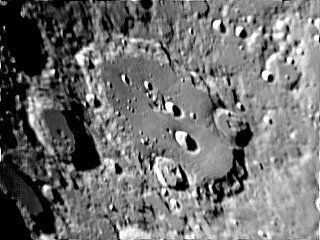
Click the image to show full resolution (0.32"/pixel)
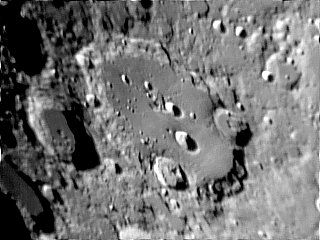
Click the image to show full resolution (0.32"/pixel)
|
Clavius
11.02.2003, 21:40-22:20 (20:40-21:20 UT)
Moon Age: 10d 10h
Resolution: 0.64 arcsec/pixel
Telescope: 8" OrionOptics Newtonian (f=1200mm)
Camera: Vesta 680K + Barlow 3X
Result focal length: 3600mm
Exposure: 300x1/100s (gain 50%)
Capturing: K3CCDTools
Processing: Registax + K3CCDTools
Seeing: very strong wind with strokesThis is
my favourite crater. Its walled plain is
decorated by a half circle of 6 small craters
like a string of pearls. They are nicely sorted
according to size - Rutherfurd - Clavius D - C -
N - J - JA. The diameter of Clavius is 225km.
| Object |
Size |
| Clavius |
225km |
| Rutherfurd |
48 x 54 km |
| Porter |
52km |
| Blancanus |
105km |
The seeing was very unsteady - I have never
encountered such bad seeing so far. I was not
able to focus! You can look at sample AVI which
demonstrates the poor seeing conditions here.
But I haven't given up and I captured 11 AVI
files with total size of 2GB - 3327 frames. First
of all I had to filter a large amount of useless
frames.
Processing:
1, From each captured AVI file I automatically
selected the best frames in K3CCDTools and
exported them to BMP sequence - as a result I got
about 1600 frames
2, I loaded 1600 BMP frames into K3CCDTools and
export them to AVI file
3, 300 best frames were stacked in Registax
4, Soft wavelet in Registax
5, Unsharp mask (1, 0, 133) in K3CCDTools
6, Converted to grayscale in PhotoPaint
7, Gaussian blur 0.6pix + adaptive unsharp mask
75%
The second image is the result of processing
the stacked image from Registax (product of step
3,) and further processing in K3CCDTools:
4, Unsharp mask (3, 0, 500) in K3CCDTools
5, Unsharp mask (2, 0, 150) in K3CCDTools
6, Converted to grayscale in PhotoPaint
7, Gaussian blur 0.6pix + adaptive unsharp mask
75%
More information about Processing
High Resolution Moon Images
Compare this photo to the photo
taken by my old small telescope.
|

Click the image to show full resolution (0.48"/pixel) |
Clavius
21.4.2002, 22:00 (20:00 UT)
Moon Age: 9d 0h
Resolution: 0.96 arcsec/pixel
Telescope: 8" OrionOptics Newtonian (f=1200mm)
Camera: Vesta 680K + Barlow 2X
Result focal length: 2400mm
Exposure: 150x1/25s (gain 5%)
Capturing: K3CCDTools
Processing: Registax + K3CCDTools
Seeing: strong wind with strokes
Processing:
1, Stacked in Registax (40 best frames) with
Partial coverage + Expand image options checked
2, Soft wavelet in Registax + gamma 1.10
3, Unsharp mask (1, 0, 200) in K3CCDTools
4, Color balance and histogram stretching in
Corel PhotoPaint
More information about Processing
High Resolution Moon Images
Compare this photo to the photo
taken by my old small telescope.
|
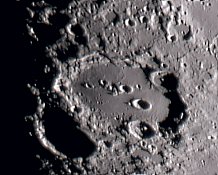
Click the
image to show full resolution (0.48"/pixel) |
The same AVI file as above, but
for all processing was used only K3CCDTools Processing:
1, Automatic selection of 150 best frames in K3CCDTools
2, Stacked in X2 mode in K3CCDTools
3, Histogram color autobalance + gamma 1.10 +
unsharp mask (3, 0, 600) in K3CCDTools
4, Saved as PNG image and loaded into another K3CCDTools
session
5, Applied another unsharp mask (2, 0, 100) to
PNG image
More information about Processing
High Resolution Moon Images
Compare this photo to the photo
taken by my old small telescope.
|
Rupes Recta & Rima Birt
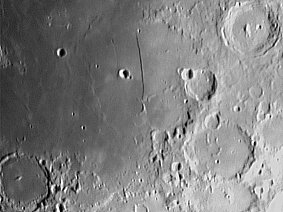
Click the
image to show full resolution (0.48"/pixel) |
Rupes Recta & Rima
Birt
21.4.2002, 21:52 (19:52 UT)
Moon Age: 9d 0h
Resolution: 0.96 arcsec/pixel
Telescope: 8" OrionOptics Newtonian (f=1200mm)
Camera: Vesta 680K + Barlow 2X
Result focal length: 2400mm
Exposure: 6x1/25s (gain 5%)
Capturing: K3CCDTools
Processing: K3CCDTools (UnsharpMask 2,0,300) +
Corel PhotoPaint
Seeing: strong wind with strokesRupes Recta (The
Straight Wall) is the best known breakage on the
Moon. Parallel to Rupes Recta the Rima Birt is
situated. Craters Birt and Birt A are nicely
visible.
| Object |
Size |
| Rupes Recta |
Length 110km, height
240-300m, apparent width 2.5km |
| Rima Birt |
Length 50km, width 1.5km |
| Crater Birt |
17km / 3470m |
| Crater Birt A |
6.8km / 1040m |
Compare this photo to the photo
taken by my old small telescope.
|

Click the
image to show full resolution (0.48"/pixel) |
Rupes Recta & Rima
Birt
21.4.2002, 21:55 (19:55 UT)
Moon Age: 9d 0h
Resolution: 0.96 arcsec/pixel
Telescope: 8" OrionOptics Newtonian (f=1200mm)
Camera: Vesta 680K + Barlow 2X
Result focal length: 2400mm
Exposure: 6x1/25s (gain 5%)
Capturing: K3CCDTools
Processing: K3CCDTools (X2 mode) + Maxim DL Demo
+ Corel PhotoPaint
Seeing: strong wind with strokesThe same
night, another AVI file
|
Crater Plato &
Vallis Alpes

Click the
image to show full resolution (0.48"/pixel) |
Crater Plato &
Vallis Alpes
21.4.2002, 21:42 (19:42 UT)
Moon Age: 9d 0h
Resolution: 0.96 arcsec/pixel
Telescope: 8" OrionOptics Newtonian (f=1200mm)
Camera: Vesta 680K + Barlow 2X
Result focal length: 2400mm
Exposure: 6x1/25s (gain 5%)
Capturing: K3CCDTools
Processing: K3CCDTools (Y channel
used, X2, UnsharpMask 4,0,200) + Corel
PhotoPaint
Seeing: strong wind with strokesNice shadow of
Plato's crater border is visible in the bottom of
crater Plato. In the bottom of Vallis Alpes there
is a very thin furrow - only a few hundreed
meters wide. It is not visible in my photograph,
but it is challenge for me to future.
The conditions were rather bad - strong wind
strokes cased scope vibrations. I captured AVIs
between these wind strokes. I also noticed, that
my scope was not properly collimated, but I
didn't want to adjust it in such windy weather.
| Object |
Size |
| Plato |
101km / 2000m |
| Vallis Alpes |
Length: 130km
Width: 10km |
Compare this photo to the photo
taken by my old small telescope.
|
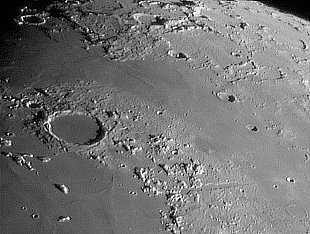
Click the
image to show full resolution (0.48"/pixel) |
The same source as above, but
traditional RGB processing. The same post-processing
as above was used (the same unsharp mask
parameters). |
Craters Copernicus &
Eratosthenes
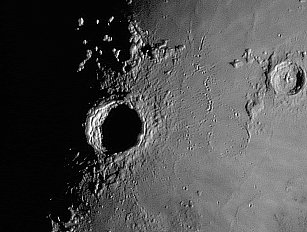
Click the
image to show full resolution (0.48"/pixel) |
Crater Copernicus
21.4.2002, 21:49 (19:49 UT)
Moon Age: 9d 0h
Resolution: 0.96 arcsec/pixel
Telescope: 8" OrionOptics Newtonian (f=1200mm)
Camera: Vesta 680K + Barlow 2X
Result focal length: 2400mm
Exposure: 8x1/25s (gain 5%)
Capturing: K3CCDTools
Processing: K3CCDTools (UnsharpMask 2,0,200) +
Corel PhotoPaint
Seeing: strong wind with strokesThe
conditions were rather bad - strong wind strokes
cased scope vibrations. I captured AVIs between
these wind strokes. I also noticed, that my scope
was not properly collimated, but I didn't want to
adjust it in such windy weather.
| Object |
Size |
| Copernicus |
93km / 3760m |
| Eratosthenes |
58km / 3570m |
|
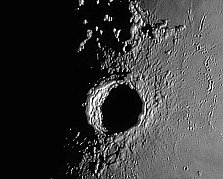
Click the
image to show full resolution (0.48"/pixel) |
Crater Copernicus -
Detail
21.4.2002, 21:49 (19:49 UT)
Moon Age: 9d 0h
Resolution: 0.96 arcsec/pixel
Telescope: 8" OrionOptics Newtonian (f=1200mm)
Camera: Vesta 680K + Barlow 2X
Result focal length: 2400mm
Exposure: 40x1/25s (gain 5%)
Capturing: K3CCDTools
Processing: K3CCDTools (X2, UnsharpMask 4,0,240)
+ Corel PhotoPaint
Seeing: strong wind with strokesThe
same AVI file as above. Unfortunatelly, the best
frames of the AVI file didn't contain
Eratosthenes crater. So I decided to process at
least nearest surrounding of Copernicus crater.
The best 40 frames were selected and stacked. The
crater is more sharp than in above photo.
|
Theophilus, Cyrillus
& Catharina Craters

Click the
image to show full resolution (0.48"/pixel) |
Theophilus, Cyrillus
& Catharina
27.6.2001, 22:00 (20:00 UT)
Moon Age: 6d 8h
Resolution: 0.96 arcsec/pixel
Telescope: 8" OrionOptics Newtonian (f=1200mm)
Camera: Vesta 680K + Barlow 2X
Result focal length: 2400mm
Exposure:
Capturing: K3CCDTools
Processing: MaximDL Demo, Corel PhotoPaint
| Crater |
Size |
| Theophilus |
100km / 4440m |
| Cyrillus |
98km |
| Catharina |
100km / 3130m |
|
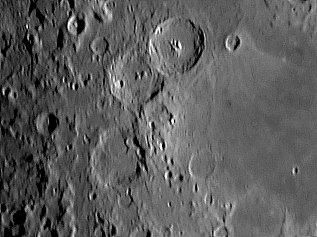
Click the
image to show full resolution (0.48"/pixel) |
New reprocessing with
new K3CCDTools (25.4.2002) The same
source as above, but new features of K3CCDTools
were used (best frames selection+unsharp-mask).
16 best frames of 111 were selected, stacked and
unsharp-masked in K3CCDTools.
|
Ptolemaeus, Alphonsus & Arzachel
Craters
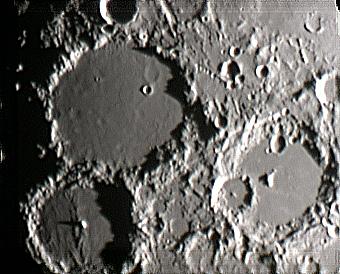
Click the
image to show full resolution (0.32"/pixel) |
Ptolemaeus
09.04.2003, 21:41 (19:41 UT)
Moon Age: 8d 1h
Resolution: 0.64 arcsec/pixel
Telescope: 8" OrionOptics Newtonian (f=1200mm)
Camera: Vesta 675SC2 + Barlow 3X, IRB
Result focal length: 3600mm
Exposure: 116x1/5s (gain 60%)
Capturing: K3CCDTools
Processing: Registax + K3CCDTools
Seeing: cloudy, image taken through clouds
Temperature: ~3°C
| Crater |
Size |
| Ptolemaeus |
153km / 2400m |
Ptolemaeus A
Ammonius |
9km / 1850m |
| Alphonsus |
118km / 2730m |
| Albategnius |
136km |
| Klein |
44km / 1460m |
When the Moon appeared in a hole between
clouds appeared, I took my scope out to the
balcony. It was in 21:05 (local time). I switched
on my fan
cooling system and in 35 minutes I was able
to image (without fan I was able to image after 2
hours). Unfortunatelly, clouds covered the whole
sky and I could image only through clouds. That's
why I had to use relatively long exposure 1/5s
and high gain.
But I am pleased with result.
It is interesting to see the central peak in
Alphonsus crater and compare it to the below
photo.
Processing:
1, I joined 3 captured AVIs into one file in by
means of VirtualDub
2, found best frame in K3CCDTools and used as
reference frame in Registax
3, 119 frames stacked in Registax in Expand mode
4, applied various wavelet settings - the borders
of photo (in Expand mode) are too distorted when
stronger wavelet is used
5, mosaic from more result bitmaps was created in
Corel PhotoPaint (softer wavelet bitmaps are used
in image borders)
6, mosaic combined with direct result of Registax
in K3CCDTools
I also tried all processing in K3CCDTools and
get very same result (undistinguishable). Finally
I used Registax result, because of its Expand
mode (wider result field of view).
|
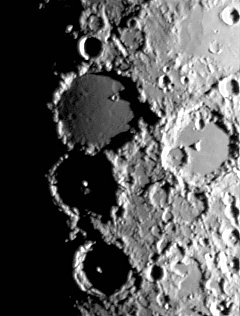
Place mouse
pointer above the photo to see the name of
craters.
Click the image to show full resolution (0.48"/pixel) |
Ptolemaeus, Alphonsus
& Arzachel Craters
28.6.2001, 22:36 (20:36 UT)
Moon Age: 7d 10h
Resolution: 0.96 arcsec/pixel
Telescope: 8" OrionOptics Newtonian (f=1200mm)
Camera: Vesta 680K + Barlow 2X
Result focal length: 2400mm
Exposure: 37 frames stacked
Capturing: K3CCDTools
Processing: Registax
| Crater |
Size |
| Ptolemaeus |
153km / 2400m |
Ptolemaeus A
Ammonius |
9km / 1850m |
| Alphonsus |
118km / 2730m |
| Arzachel |
97km / 3610m |
| Albategnius |
136km |
| Herschel |
41km /3770m |
| Klein |
44km / 1460m |
See also Stacking
versus selecting the best frame
|
Rima Ariadaeus
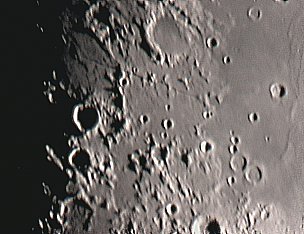
Click the
image to show full resolution (0.48"/pixel) |
Rima Ariadaeus
27.6.2001, 22:12 (20:12 UT)
Moon Age: 6d 8h
Resolution: 0.96 arcsec/pixel
Telescope: 8" OrionOptics Newtonian (f=1200mm)
Camera: Vesta 680K + Barlow 2X
Result focal length: 2400mm
Capturing: K3CCDTools
Processing: Registax (processed 1.6.2002)
|
Rima Hyginus
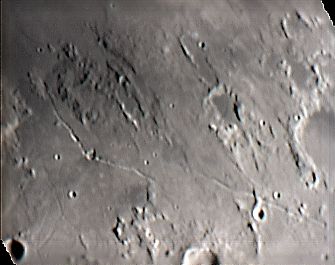
Click the
image to show full resolution (0.32"/pixel) |
Rima Hyginus
09.04.2003, 21:49 (19:49 UT)
Moon Age: 8d 1h
Resolution: 0.64 arcsec/pixel
Telescope: 8" OrionOptics Newtonian (f=1200mm)
Camera: Vesta 675SC2 + Barlow 3X, IRB
Result focal length: 3600mm
Exposure: 108x1/5s (gain 60%)
Capturing: K3CCDTools
Processing: Registax + K3CCDTools
Seeing: cloudy, image taken through clouds
Temperature: ~3°CRima Hyginus is very
interesting lunar feature. It is 220km long and
is divided by crater Hyginus. The width of rima
is 2-3km, the depth several hundreds meters.
In the lower left part Rima Triesnecker is
visible.
| Crater |
Size |
| Hyginus |
10.6km / 770m |
| Silberschlag |
13.4km / 2530m |
When the Moon appeared in a hole between
clouds appeared, I took my scope out to the
balcony. It was in 21:05 (local time). I switched
on my fan
cooling system and in 35 minutes I was able
to image (without fan I was able to image after 2
hours). Unfortunatelly, clouds covered the whole
sky and I could image only through clouds. That's
why I had to use relatively long exposure 1/5s
and high gain.
That's why the result is rather noisy and not
sharp.
Processing:
1, I joined 3 captured AVIs into one file in by
means of VirtualDub
2, found best frame in K3CCDTools and used as
reference frame in Registax
3, 108 frames stacked in Registax in Expand mode
4, applied various wavelet settings - the borders
of photo (in Expand mode) are too distorted when
stronger wavelet is used
5, mosaic from more result bitmaps was created in
Corel PhotoPaint (softer wavelet bitmaps are used
in image borders)
|
Back to Moon Page
Computer generated images,
real images, drawings and texts are property of the
author and may not be reproduced or used without
permission of author.

Last Update:
12.04.2003
|